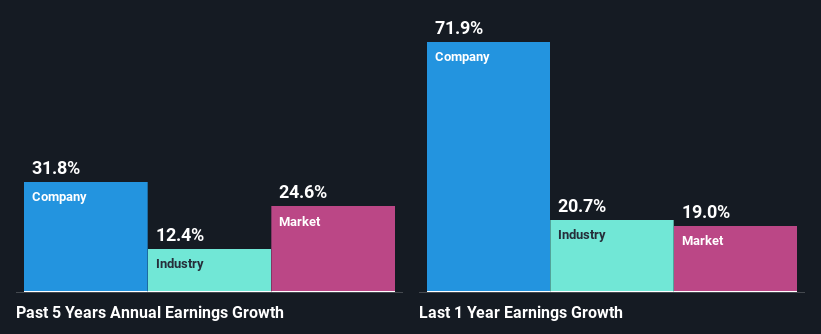JFL Life Sciences Limited's (NSE:JFLLIFE) Stock Has Seen Strong Momentum: Does That Call For Deeper Study Of Its Financial Prospects?
Most readers would already be aware that JFL Life Sciences' (NSE:JFLLIFE) stock increased significantly by 21% over the past week. As most would know, fundamentals are what usually guide market price movements over the long-term, so we decided to look at the company's key financial indicators today to determine if they have any role to play in the recent price movement. Specifically, we decided to study JFL Life Sciences' ROE in this article.
Return on Equity or ROE is a test of how effectively a company is growing its value and managing investors’ money. Put another way, it reveals the company's success at turning shareholder investments into profits.
How Do You Calculate Return On Equity?
ROE can be calculated by using the formula:
Return on Equity = Net Profit (from continuing operations) ÷ Shareholders' Equity
So, based on the above formula, the ROE for JFL Life Sciences is:
14% = ₹54m ÷ ₹389m (Based on the trailing twelve months to September 2024).
The 'return' is the income the business earned over the last year. Another way to think of that is that for every ₹1 worth of equity, the company was able to earn ₹0.14 in profit.
Check out our latest analysis for JFL Life Sciences
Why Is ROE Important For Earnings Growth?
Thus far, we have learned that ROE measures how efficiently a company is generating its profits. Based on how much of its profits the company chooses to reinvest or "retain", we are then able to evaluate a company's future ability to generate profits. Assuming all else is equal, companies that have both a higher return on equity and higher profit retention are usually the ones that have a higher growth rate when compared to companies that don't have the same features.
JFL Life Sciences' Earnings Growth And 14% ROE
At first glance, JFL Life Sciences' ROE doesn't look very promising. However, given that the company's ROE is similar to the average industry ROE of 13%, we may spare it some thought. Particularly, the exceptional 32% net income growth seen by JFL Life Sciences over the past five years is pretty remarkable. Given the slightly low ROE, it is likely that there could be some other aspects that are driving this growth. Such as - high earnings retention or an efficient management in place.
As a next step, we compared JFL Life Sciences' net income growth with the industry, and pleasingly, we found that the growth seen by the company is higher than the average industry growth of 12%.

Earnings growth is an important metric to consider when valuing a stock. What investors need to determine next is if the expected earnings growth, or the lack of it, is already built into the share price. Doing so will help them establish if the stock's future looks promising or ominous. Is JFL Life Sciences fairly valued compared to other companies? These 3 valuation measures might help you decide.
Is JFL Life Sciences Efficiently Re-investing Its Profits?
JFL Life Sciences' ' three-year median payout ratio is on the lower side at 6.3% implying that it is retaining a higher percentage (94%) of its profits. So it looks like JFL Life Sciences is reinvesting profits heavily to grow its business, which shows in its earnings growth.
Along with seeing a growth in earnings, JFL Life Sciences only recently started paying dividends. Its quite possible that the company was looking to impress its shareholders.
Summary
In total, it does look like JFL Life Sciences has some positive aspects to its business. Even in spite of the low rate of return, the company has posted impressive earnings growth as a result of reinvesting heavily into its business. While we won't completely dismiss the company, what we would do, is try to ascertain how risky the business is to make a more informed decision around the company. You can see the 2 risks we have identified for JFL Life Sciences by visiting our risks dashboard for free on our platform here.
Have feedback on this article? Concerned about the content? Get in touch with us directly. Alternatively, email editorial-team (at) simplywallst.com.
This article by Simply Wall St is general in nature. We provide commentary based on historical data and analyst forecasts only using an unbiased methodology and our articles are not intended to be financial advice. It does not constitute a recommendation to buy or sell any stock, and does not take account of your objectives, or your financial situation. We aim to bring you long-term focused analysis driven by fundamental data. Note that our analysis may not factor in the latest price-sensitive company announcements or qualitative material. Simply Wall St has no position in any stocks mentioned.
 Wall Street Journal
Wall Street Journal